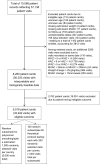Acute malnutrition recovery energy requirements based on mid-upper arm circumference: Secondary analysis of feeding program data from 5 countries, Combined Protocol for Acute Malnutrition Study (ComPAS) Stage 1
- PMID: 32492023
- PMCID: PMC7269364
- DOI: 10.1371/journal.pone.0230452
Acute malnutrition recovery energy requirements based on mid-upper arm circumference: Secondary analysis of feeding program data from 5 countries, Combined Protocol for Acute Malnutrition Study (ComPAS) Stage 1
Abstract
Background: Severe and moderate acute malnutrition (SAM and MAM) are currently treated with different food products in separate treatment programs. The development of a unified and simplified treatment protocol using a single food product aims to increase treatment program efficiency and effectiveness. This study, the first stage of the ComPAS trial, sought to assess rate of growth and energy requirements among children recovering from acute malnutrition in order to design a simplified, MUAC-based dosage protocol.
Methods: We obtained secondary data from patient cards of children aged 6-59 months recovering from SAM in outpatient therapeutic feeding programs (TFPs) and from MAM in supplementary feeding programs (SFPs) in five countries in Africa and Asia. We used local polynomial smoothing to assess changes in MUAC and proportional weight gain between clinic visits and assessed their normalized differences for a non-zero linear trend. We estimated energy needs to meet or exceed the growth observed in 95% of visits.
Results: This analysis used data from 5518 patients representing 33942 visits. Growth trends in MUAC and proportional weight gain were not significantly different, each lower at higher MUAC values: MUAC growth averaged 2mm/week at lower MUACs (100 to <110mm) and 1mm/week at higher MUACs (120mm to <125mm); and proportional weight gain declined from 3.9g/kg/day to 2.4g/kg/day across the same MUAC values. In 95% of visits by children with a MUAC 100mm to <125mm who were successfully treated, energy needs could be met or exceeded with 1,000 kilocalories a day.
Conclusion: Two 92g sachets of Ready-to-Use Therapeutic Food (RUTF) (1,000kcal total) is proposed to meet the estimated total energy requirements of children with a MUAC 100mm to <115mm, and one 92g sachet of RUTF (500kcal) is proposed to meet half the energy requirements of children with a MUAC of 115 to <125mm. A simplified, combined protocol may enable a more holistic continuum of care, potentially contributing to increased coverage for children suffering from acute malnutrition.
Conflict of interest statement
The authors have declared that no competing interests exist.
Figures




References
-
- United Nations Children’s Fund, World Health Organization, World Bank. Levels and trends in child malnutrition: Key findings of the 2018 edition of the joint child malnutrition estimates [Internet]. New York, Geneva; 2018 [cited 2019 Jul 19]. Available from: https://www.who.int/nutgrowthdb/2018-jme-brochure.pdf
-
- Isanaka S, Boundy EO, Grais RF, Myatt M, Briend A. Improving estimates of numbers of children with severe acute malnutrition using cohort and survey data. Am J Epidemiol [Internet]. 2016. December 15 [cited 2018 Jul 6];184(12):861–9. Available from: https://academic.oup.com/aje/article-lookup/doi/10.1093/aje/kww129 - DOI - PubMed
-
- Dale NM, Myatt M, Prudhon C, Briend A. Using cross-sectional surveys to estimate the number of severely malnourished children needing to be enrolled in specific treatment programmes. Public Health Nutr [Internet]. 2017. June 24 [cited 2018 Jul 15];20(8):1362–6. Available from: https://www.cambridge.org/core/product/identifier/S1368980016003578/type... 10.1017/S1368980016003578 - DOI - PMC - PubMed
-
- Deconinck H, Pesonen A, Hallarou M, Gérard J-C, Briend A, Donnen P, et al. Challenges of Estimating the Annual Caseload of Severe Acute Malnutrition: The Case of Niger. Noor AM, editor. PLoS One [Internet]. 2016. September 8 [cited 2018 Jul 15];11(9):e0162534 Available from: 10.1371/journal.pone.0162534 - DOI - PMC - PubMed
-
- Hure A, Oldmeadow C, Attia J. Invited commentary: Improving estimates of severe acute malnutrition requires more data. Am J Epidemiol [Internet]. 2016. December 15 [cited 2018 Jul 6];184(12):870–2. Available from: https://academic.oup.com/aje/article-lookup/doi/10.1093/aje/kww131 - DOI - PubMed
Publication types
MeSH terms
LinkOut - more resources
Full Text Sources
Medical
Miscellaneous

